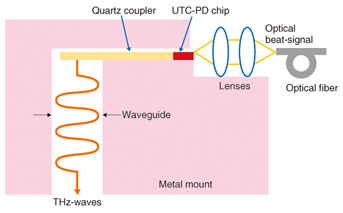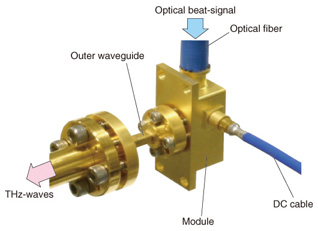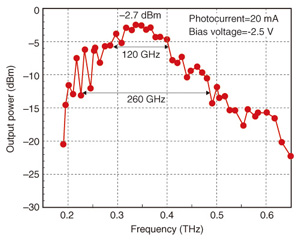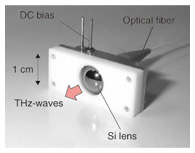 |
|||||||||||||||
|
|
|||||||||||||||
|
Feature Articles: Imaging and Sensing Technologies for Safety and Security Vol. 10, No. 2, pp. 25–31, Feb. 2012. https://doi.org/10.53829/ntr201202fa5 Development of Terahertz-wave Photomixer Module Using a Uni-traveling-carrier PhotodiodeAbstractAs a promising power source for various terahertz-wave (THz-wave) applications, we have developed a compact, lightweight, high-power, and ultrawideband THz-wave photomixer module using a uni-traveling-carrier photodiode. The module operates at room temperature and exhibits output power of over 0.5 mW at 0.35 THz and a 10-dB-down bandwidth of 260 GHz. Its output frequency can be swept continuously over an extremely wide frequency range in the terahertz band. In this article, we report on the photomixing technique using an ultrahigh-speed, high-power photodiode to generate THz-waves and the development of two versions of the photomixer module.
1. IntroductionIn both communications and non-communications fields, there have been many trials for using an unexploited frequency range, the terahertz range, for high-frequency applications. Terahertz-waves (THz-waves) are electromagnetic waves in the frequency range from 0.1 THz to 10 THz (Fig. 1). This frequency range is positioned between radio waves and light waves, so the characteristics of THz-waves are either intermediate between them or a combination of their advantages. The main features of interest are also described in Fig. 1.
Recently, various high-frequency applications utilizing these superior features of THz-waves have been actively proposed and investigated. Possible applications include an ultrahigh-capacity wireless communication system, non-destructive inspection/imaging system, spectroscopic remote sensing/analysis system, and astronomical radio telescope system, as shown in Fig. 2. THz-waves have been enthusiastically investigated especially for systems concerning human safety and rescue in light of the frequent disasters that have occurred in recent years.
A compact, lightweight, and easy-to-handle THz-wave generator is a key device for such high-frequency systems. The development of a generator that simultaneously provides high power, a wide bandwidth, and frequency-sweeping capability has been one of the most important targets in this field. 2. THz-wave generation using a photodiodeNTT Photonics Laboratories invented the uni-traveling-carrier photodiode (UTC-PD) [1] as a key device for high-speed optical communication systems and has continued to investigate it to make improvements and develop applications. The UTC-PD simultaneously achieves both ultrahigh speed and high power compared with the conventional pin-PD. This excellent feature is extremely suitable not only for a high-speed optical communication receiver but also for an electromagnetic-wave generator. The development of the THz-wave photomixer module was based on the same technology as used in the UTC-PD-based millimeter-wave photomixer module that we developed earlier [2]. The structures of both the UTC-PD and the module were improved and optimized for use in a frequency range of 0.2 THz to 0.65 THz. At present, our module has a center frequency of 0.35 THz for application as the power source of a spectroscopic remote sensing system [3]. The PD-based photomixing technique is explained in Fig. 3. THz-waves are generated by ultrahigh-speed optical-to-electrical (O/E) conversion in a UTC-PD. An optical beat-signal with a beating frequency of fb (= f1 - f2) is obtained by combining two lights of different frequencies (f1, f2; f1>f2) in an optical coupler. For example, by using lights with wavelengths of 1.5000 μm (201 THz) and 1.5075 μm (200 THz), we can get a beat signal with a frequency of exactly 1 THz. The optical beat-signal that is input into the UTC-PD is converted into a modulated electric current with the same frequency as fb. THz-waves can be obtained by radiating the modulated current into space from a waveguide or antenna.
Details of the UTC-PD used in the photomixing technique are given in the next section. 3. UTC-PD3.1 FeaturesAlthough the most widely used PD is the conventional pin-PD, there are two limitations regarding its performance (pin: positive, intrinsic, negative layers). One concerns the maximum operating speed. When lights are input into the pin-PD’s absorption layer, electron-hole pairs, which are the electric current carriers, are generated (Fig. 4(a)). In a pin-PD, both electrons and holes contribute to its O/E-conversion mechanism. Because a hole’s effective mass is larger than an electron’s and its velocity is much lower, the maximum operating speed of the pin-PD is limited by the hole velocity. The other limitation concerns the maximum output current. When the optical input power becomes higher, the band in the undoped absorption layer is bent by the space charge due to carrier accumulation. This band bending causes a drastic reduction in carrier velocity, which results in saturation of the output current. To overcome these limitations of the pin-PD, we studied the UTC-PD.
In the UTC-PD, a p-doped absorption layer is separated from a wide-gap undoped carrier collection layer (Fig. 4(b)), which is in clear contrast to the pin-PD. This structure means that only electrons are the active carriers running through the depleted undoped carrier collection layer. Most of the photogenerated holes relax extremely quickly into the absorption layer where holes are the major carrier. Consequently, the maximum operating speed of the UTC-PD is determined only by the electron velocity, which is much higher than the hole velocity. The space charge effect is also much smaller than in the pin-PD because carrier accumulation is extremely small in principle compared with the pin-PD. For these reasons, the UTC-PD can exhibit high performance, that is, ultrahigh-speed and high saturation output current simultaneously. We have achieved a 3-dB-down bandwidth of 310 GHz and a 10-dB-down bandwidth of 750 GHz as the operational frequency bandwidth [4]. We have also obtained a maximum output current of 30 mA for high optical input power. 3.2 Optimization for THz-wave photomixer moduleIt is essential to optimize the UTC-PD’s band structure in order to obtain an output current with a terahertz frequency. We designed a thinner absorption layer than the one in the UTC-PD for the previous millimeter-wave photomixer; this reduced the UTC-PD’s carrier transit time when it operates at higher frequencies. The thicknesses and materials of the other layers were also optimized for compatibility with the thin absorption layer. Besides the band structure, we also improved the physical structure of the UTC-PC chip. The fabricated UTC-PD chip designed to operate in the terahertz frequency range is shown in Fig. 5. The chip is 300 × 450 μm2.
The frequency response of the PD output current shows a generally broadband-shape caused by the resistor-capacitor time constant. The response decreases with increasing operating frequency. For the THz-wave photomixer, a stub-line was integrated on the chip to increase the output current. It acts as a resonant circuit for the UTC-PD to compensate for the roll-off of the frequency response. The output power of the THz-waves is designed to be as high as possible at around the designed center frequency. In this development, the center frequency was set to 0.35 THz. The output current is expected to increase at around the center frequency through use of the resonant effect. We measured the pulse photoresponse to evaluate the chip’s resonant design. From the measured pulse waveform oscillating at about 0.35 THz, we ascertained that the stub-line acted properly as a resonant circuit. 4. Waveguide-output-type photomixer module4.1 OptimizationFor practical use, in addition to being high-performance, the photomixer module is required to be compact, lightweight, and easy to handle. Moreover, since the module will be applied to various high-frequency systems, it should be easy to assemble on a board or in a package. As a result of our investigation, we determined that a butterfly-package would be an excellent form for the module. It is a generic package with a good track record for many optical devices, so it is cheap and readily available. For the module structure investigation, there are two main issues: they concern optical implementation and electrical implementation. The former covers how efficiently light is input to the UTC-PD, and the latter covers how efficiently ultrahigh-frequency current from the UTC-PD is converted into THz-waves. Today’s high-frequency coaxial connectors have pronounced propagation loss for current with a frequency range above 0.1 THz, so it is essential to chose either the waveguide technique or direct radiation technique (quasi-optical technique) to output the current from the module. We developed a waveguide-based module structure during our development of the previous millimeter-wave photomixer module and confirmed its excellent characteristics. The THz-wave photomixer module is based on an extension of that technique. The cross-section of the internal structure is schematically shown in Fig. 6. The optical part consists of an optical fiber and collimation lenses. The collimation lens system has good versatility for an optical design, and it also has excellent optical alignment stability among the optical fiber, lenses, and UTC-PD. The UTC-PD chip is mounted on a metal block with a rectangular waveguide whose aperture size is 0.864 mm × 0.432 mm. The UTC-PD chip and the waveguide are connected by a quartz coupler consisting of an impedance converter, a micro-strip line, and a radiator. The module is made by assembling these components in the butterfly-package with the same waveguide.
The design of the quartz coupler is extremely important for high emission efficiency of the ultrahigh-frequency current as THz-waves into the waveguide. The design policies were as follows: (1) Reflection power as low as possible (2) Transmission power as high as possible (3) Propagation of higher-order modes in the waveguide suppressed as much as possible from the UTC-PD’s current output point to the waveguide’s THz-wave output point. The quartz coupler was designed using a three-dimensional electromagnetic wave simulator to obtain flattened characteristics from 0.2 THz to 0.65 THz. As a result of simulation for various designs, the optimized one achieved reflection power of less than -30 dB and transmission power loss of less than 3 dB. 4.2 PerformanceWe fabricated a THz-wave photomixer module (Fig. 7) with the optimized design described in the previous section. The module is 3 × 1.65 × 1 cm3.
The output power dependence on frequency when the optical beat signal’s frequency was swept from 0.2 THz to 0.65 THz is shown in Fig. 8. The output power was clearly enhanced at around 0.35 THz (designed center frequency of the stub-line) with the maximum value being over 0.5 mW [5]. This is the highest value ever reported for a photomixer with a single PD operating in this frequency range. The 3- and 10-dB-down bandwidths were as wide as 120 and 260 GHz, respectively, showing extremely wideband performance.
The main feature of this module is that it simultaneously achieves both high-output power and extremely wide bandwidth. In addition to this high performance, it is very easy to use because it operates in continuous-wave operation at room temperature without any cooling. 5. Quasi-optical photomixer moduleFor diversification of the THz-wave output method, we have been also investigating a quasi-optical photomixer module (Fig. 9). The THz-wave generation principle is the same as for the waveguide-output-type module. The quasi-optical module consists of a UTC-PD chip integrated with an antenna and a metal package with a silicon lens for collimating the radiated THz-waves.
In the waveguide-output-type module, as the operation frequency becomes higher, the waveguide’s aperture must become smaller. Therefore, in the terahertz range, it becomes difficult to fabricate a precise rectangular waveguide with a small aperture by a metal-cutting process. The quasi-optical module is suitable for increasing the operating frequency because it does not require high-precision metal-cutting. There are also some other good features: (1) It is easy to make either a broadband- or resonant-type module by choosing the type of integrated antenna. (2) It is easy to fabricate an airtight module, which is beneficial for module reliability because the module does not have an aperture. (3) The electrical implementation is easy because that there is no quartz coupler requiring precise positional alignment. Although the maximum output power is lower than that of the waveguide-output-type module at present, we confirmed THz-wave generation up to a frequency of 1.5 THz [6]. 5. ConclusionThe features of the UTC-PD were described, including the operating principles and characteristics. Compared with the conventional pin-PD, the UTC-PD has the advantages of extremely wide bandwidth and high power owing to its unique carrier transport mechanism. One application for the UTC-PD is THz-wave generation. Our developed THz-wave photomixer module using a UTC-PD, fabricated as a waveguide-output-type module, exhibits excellent performance. It has a maximum output power of over 0.5 mW at 0.35 THz and a 10-dB-down bandwidth of 260 GHz. This maximum output power is the highest value ever reported for direct generation from a photomixer operating in a frequency range of 0.2 THz to 0.65 THz. Our UTC-PD-based quasi-optical module generates THz-waves up to a maximum frequency of 1.5 THz. AcknowledgmentPart of this work was supported by the National Institute of Information and Communications Technology, Japan. References
|
|||||||||||||||



















